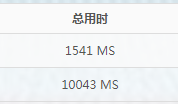快读
正数快读
inline int read() { int s=0; char c=getchar(); while (c<'0' || c>'9') c=getchar(); while (c>='0' && c<='9') s=s*10+c-'0',c=getchar(); return s; }
输入方式
int main() { n=read(),x=read(); ...... }
正负皆可的快读
template <typename T> inline void read(T& x) { char ch=getchar(); bool sign=true; while(!isdigit(ch)) { if(ch=='-')sign=false; ch=getchar(); } for(x=0; isdigit(ch); ch=getchar())x=x*10+ch-'0'; if(!sign)x=-x; }
输入方式
int main() { read(n),read(x); ...... }
急速快读
inline char nc(){ static char buf[100000],*p1=buf,*p2=buf; return p1==p2&&(p2=(p1=buf)+fread(buf,1,100000,stdin),p1==p2)?EOF:*p1++; } inline int rd(){ char ch=nc();int sum=0; while(!(ch>='0'&&ch<='9'))ch=nc(); while(ch>='0'&&ch<='9')sum=sum*10+ch-48,ch=nc(); return sum; }
输入方式
int main() { n=rd(); ...... }
注:使用fread之后你的程序将不能手动输入数据,且与多个输入输出方式不兼容,所以除非为大数据,不建议使用
比较
下为普通getchar快读,上为fread快读

快写
代码
#define I_int int char F[ 200 ] ; inline void write( I_int x ) { I_int tmp = x > 0 ? x : -x ; if( x < 0 ) putchar( '-' ) ; int cnt = 0 ; while( tmp > 0 ) { F[ cnt ++ ] = tmp % 10 + '0' ; tmp /= 10 ; } while( cnt > 0 ) putchar( F[ -- cnt ] ) ; } #undef I_int
输出方式
int main() { ...... write(n); }